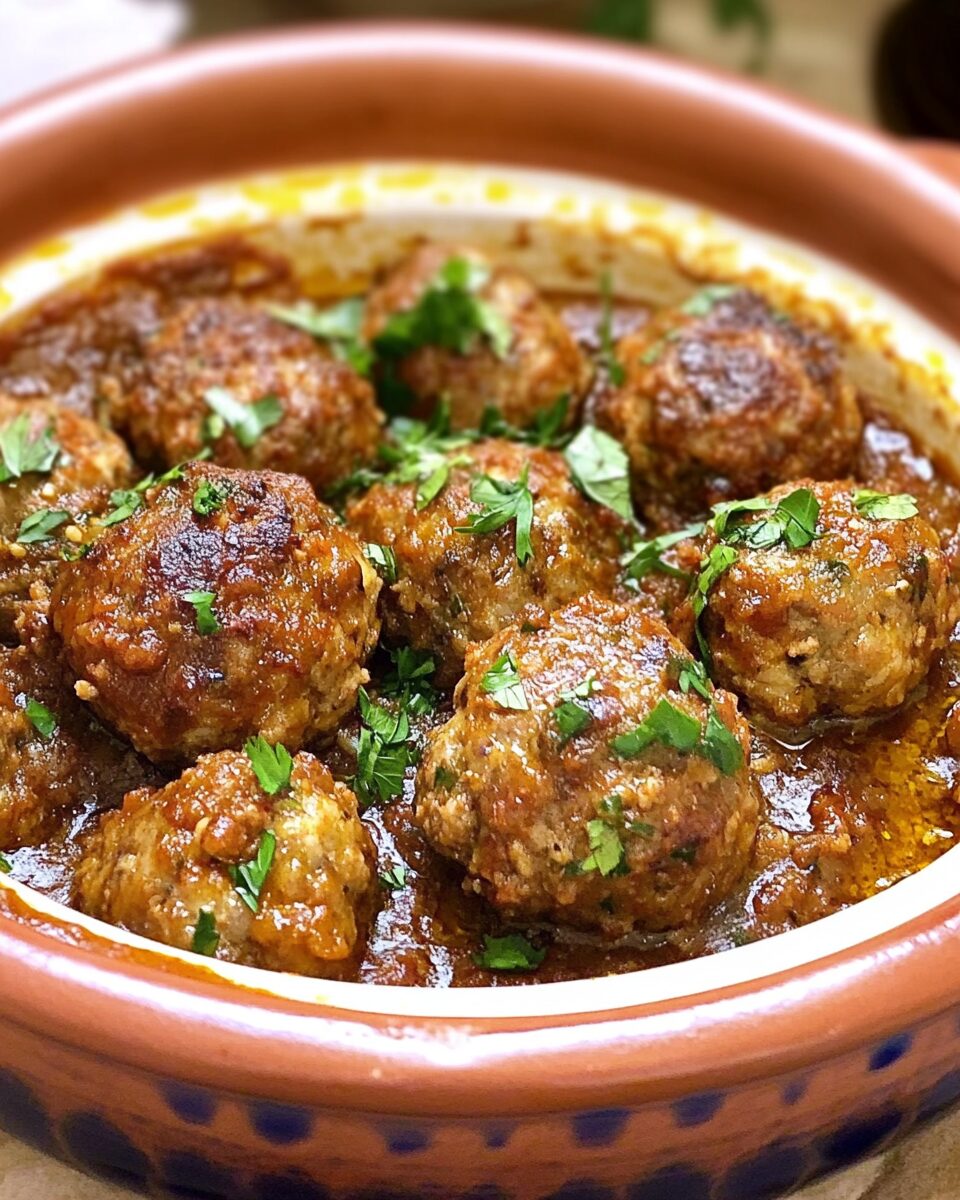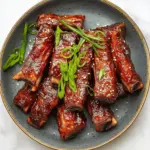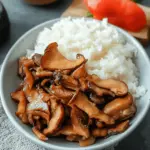These Moroccan meatballs, simmered in a slightly sweet tomato sauce with aromatic spices, create a dish that’s both comforting and exotic. The tender meatballs are packed with cumin, coriander, and paprika, bringing a rich and fragrant flavor to the table.
This dish is perfect for cozy dinners or special occasions when you want to impress. Serve them over couscous or rice, or alongside roasted vegetables for a balanced meal. The sweet and savory combination of the sauce, paired with the spiced meatballs, will make everyone ask for seconds.
Full Recipe
Ingredients:
- 1 lb ground beef
- 1/2 cup breadcrumbs
- 1/4 cup parsley, chopped
- 1 small onion, finely chopped
- 2 cloves garlic, minced
- 1 teaspoon cumin
- 1 teaspoon coriander
- 1 teaspoon paprika
- 1/2 teaspoon cinnamon
- Salt and pepper to taste
- 1 egg
- 2 tablespoons olive oil
- 1 cup tomato sauce
- 1/4 cup chicken broth
- 1 tablespoon honey
- Fresh cilantro for garnish
Directions:
- In a large bowl, mix together the ground beef, breadcrumbs, parsley, onion, garlic, cumin, coriander, paprika, cinnamon, egg, salt, and pepper.
- Form the mixture into meatballs, about 1 inch in diameter.
- Heat olive oil in a large skillet over medium heat. Add the meatballs and cook for about 7-8 minutes, turning to brown all sides.
- While the meatballs are cooking, combine the tomato sauce, chicken broth, and honey in a small saucepan and bring to a simmer.
- Once the meatballs are browned, pour the sauce over them in the skillet. Reduce the heat and simmer for 15 minutes, or until the meatballs are cooked through.
- Garnish with fresh cilantro and serve hot.
Prep Time: 10 minutes | Cooking Time: 20 minutes | Total Time: 30 minutes
Kcal: 320 kcal | Servings: 4 servings
Introduction to Moroccan Meatballs
Moroccan cuisine is famous for its vibrant flavors, rich spices, and unique blend of ingredients. One of the most beloved dishes from this region is the Moroccan meatball, known for its aromatic spices and comforting texture. These meatballs, which are tender, juicy, and bursting with spices, have a deep cultural significance in Moroccan food traditions. While they’re often served with couscous or rice, they can also be enjoyed on their own with a side of vegetables or bread to soak up the sauce.
Moroccan meatballs, or Kefta, are a true representation of the region’s culinary creativity. This dish is not just about the meatballs themselves, but about the flavorful sauce that ties everything together, enhancing every bite. Whether you’re a fan of Middle Eastern and North African cuisine or just looking for something new to try, Moroccan meatballs are a must-try that will undoubtedly become a staple in your recipe collection.
The History of Moroccan Meatballs
Moroccan meatballs have their roots in the diverse and rich culinary heritage of Morocco. Influenced by Berber, Arab, and Mediterranean flavors, Moroccan cuisine incorporates a range of ingredients from various regions. Meatballs, or Kefta, are a popular dish in many households, often made with lamb or beef, and are a common choice for family meals, as well as for special occasions.
The recipe for Moroccan meatballs dates back centuries, possibly originating in ancient North African kitchens where spices like cumin, coriander, cinnamon, and paprika were already part of the region’s spice trade. These meatballs often served as a way to utilize less expensive cuts of meat, turning them into something flavorful and satisfying. Over time, the recipe has evolved, with variations that include different meats, vegetables, and spice blends, reflecting the changes in Moroccan society and culture.
Key Ingredients in Moroccan Meatballs
What sets Moroccan meatballs apart from other meatball recipes is the unique blend of spices and the way they are combined into a sauce. While the main ingredient is typically ground beef or lamb, the real flavor comes from the spices and herbs.
Spices and Herbs: Moroccan meatballs are known for their warm and aromatic spice blend. Key spices such as cumin, coriander, cinnamon, and paprika are mixed together to give the meatballs a distinctive, aromatic flavor profile. Cinnamon adds a subtle sweetness that balances out the heat from the paprika, while cumin and coriander offer a depth of flavor. Fresh herbs like parsley and cilantro are commonly used to add freshness and brightness.
Tomato Sauce and Broth: The meatballs are often simmered in a rich tomato sauce, sometimes enriched with chicken broth and honey. The sweetness from the honey balances the spices, and the broth helps create a savory, fragrant sauce that complements the meatballs perfectly.
Egg and Breadcrumbs: To ensure the meatballs are tender and juicy, eggs and breadcrumbs are added to the meat mixture. These ingredients help bind the meatballs together while also contributing to their softness.
Cilantro for Garnish: A generous sprinkle of fresh cilantro is the finishing touch on Moroccan meatballs, bringing a burst of freshness that brightens the entire dish.
The Cooking Process: Perfecting the Moroccan Meatball
The beauty of Moroccan meatballs lies in the way they are prepared. The mixture of spices and herbs is massaged into the meat, creating flavor-packed little orbs that will delight your taste buds. Cooking the meatballs is a simple yet rewarding process.
First, you brown the meatballs in olive oil to create a caramelized exterior, which adds to the overall texture of the dish. Once browned, the meatballs are gently simmered in a rich tomato sauce, which infuses them with even more flavor. The sauce reduces and thickens, coating each meatball in a savory, aromatic glaze. This simmering process allows the flavors to meld together, making the dish incredibly aromatic and flavorful.
Serving Moroccan Meatballs
Moroccan meatballs are incredibly versatile when it comes to serving. Traditionally, they are paired with couscous, which soaks up the delicious sauce and adds texture to the dish. Couscous, a steamed semolina dish, is a great way to balance out the rich, spicy flavors of the meatballs. You could also serve these meatballs with rice, flatbread, or a side of roasted vegetables to make a complete meal.
These meatballs are also a great addition to a meze platter or as part of a Mediterranean spread. They can be served with a yogurt-based dipping sauce or a side of harissa (a spicy North African chili paste) to add even more depth of flavor. If you’re hosting a gathering or a family dinner, Moroccan meatballs will make an impression as they offer both rich flavor and beautiful presentation.
Moroccan Meatballs as a Versatile Dish
What makes Moroccan meatballs even more appealing is their versatility. They can be adapted to suit various dietary preferences or personalized with additional ingredients. For example, if you prefer a leaner option, you can swap out beef for ground turkey or chicken. If you’re vegetarian, try making chickpea-based meatballs seasoned with Moroccan spices. Additionally, you can experiment with adding extra vegetables to the meatball mixture, such as grated carrots or zucchini, for a healthier twist.
For those who are gluten-free, you can replace the breadcrumbs with gluten-free alternatives, such as almond flour or rice crumbs, without compromising the texture or flavor of the meatballs. The sauce can also be easily customized to your liking, adding more spice or sweetness based on your preference.
The Health Benefits of Moroccan Meatballs
While Moroccan meatballs are undeniably flavorful, they also provide nutritional benefits. The use of lean meats like beef or lamb ensures a good source of protein, iron, and essential vitamins. Additionally, the spices used in Moroccan meatballs—such as cumin, coriander, and cinnamon—are known for their anti-inflammatory properties and digestive benefits. Cinnamon, in particular, has been shown to help regulate blood sugar levels, while cumin supports digestion and overall gut health.
The addition of fresh herbs like parsley and cilantro provides vitamins A, C, and K, along with antioxidants that can help support the immune system. These meatballs, when paired with a healthy grain like couscous or quinoa, provide a well-rounded, nutritious meal.
Moroccan Meatballs in Different Cultures
While Moroccan meatballs are a staple in North African cuisine, variations of this dish can be found across the Mediterranean and Middle Eastern regions. Many cultures have their own take on meatballs, from the Greek keftedes to the Turkish köfte. The common thread in these dishes is the use of aromatic spices and herbs to flavor the meat, making them a beloved part of culinary traditions worldwide.
In Morocco, these meatballs are often served with a side of olives, roasted vegetables, or a fresh salad. The versatility and adaptability of this dish have made it a favorite not only in its place of origin but also in homes around the world.
Conclusion
Moroccan meatballs are more than just a meal—they are an exploration of rich, bold flavors and a tribute to Morocco’s diverse culinary history. The combination of spices, fresh herbs, and the savory tomato sauce makes this dish a perfect representation of North African cuisine. Whether served on their own, with couscous, or alongside vegetables, Moroccan meatballs are a satisfying and flavorful choice for any occasion. The versatility of the recipe allows for endless customization, making it a dish that can be enjoyed by people with a wide range of tastes and dietary preferences.
The cultural significance of Moroccan meatballs adds another layer to their appeal. From humble family dinners to grand celebrations, these meatballs have remained a beloved dish that brings people together around the table. With their perfect balance of savory and sweet, these meatballs are sure to become a new favorite in your recipe collection.





